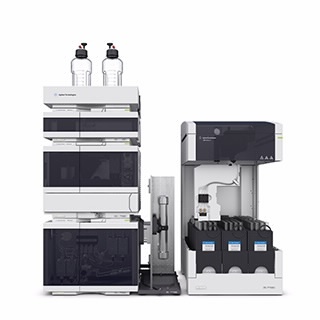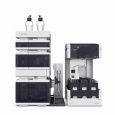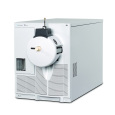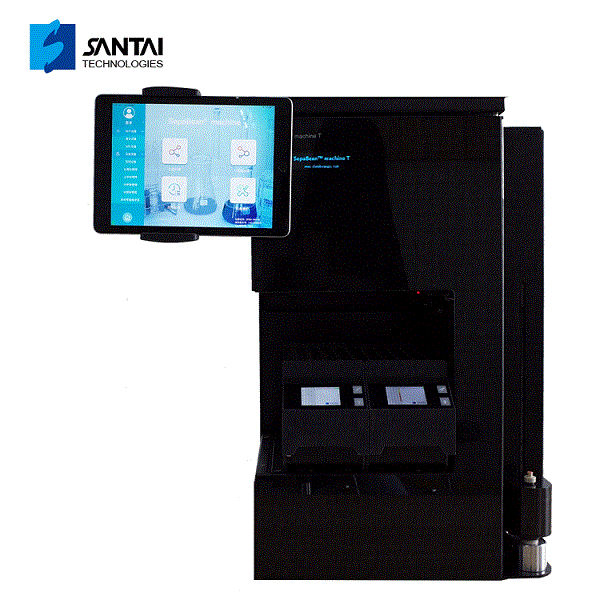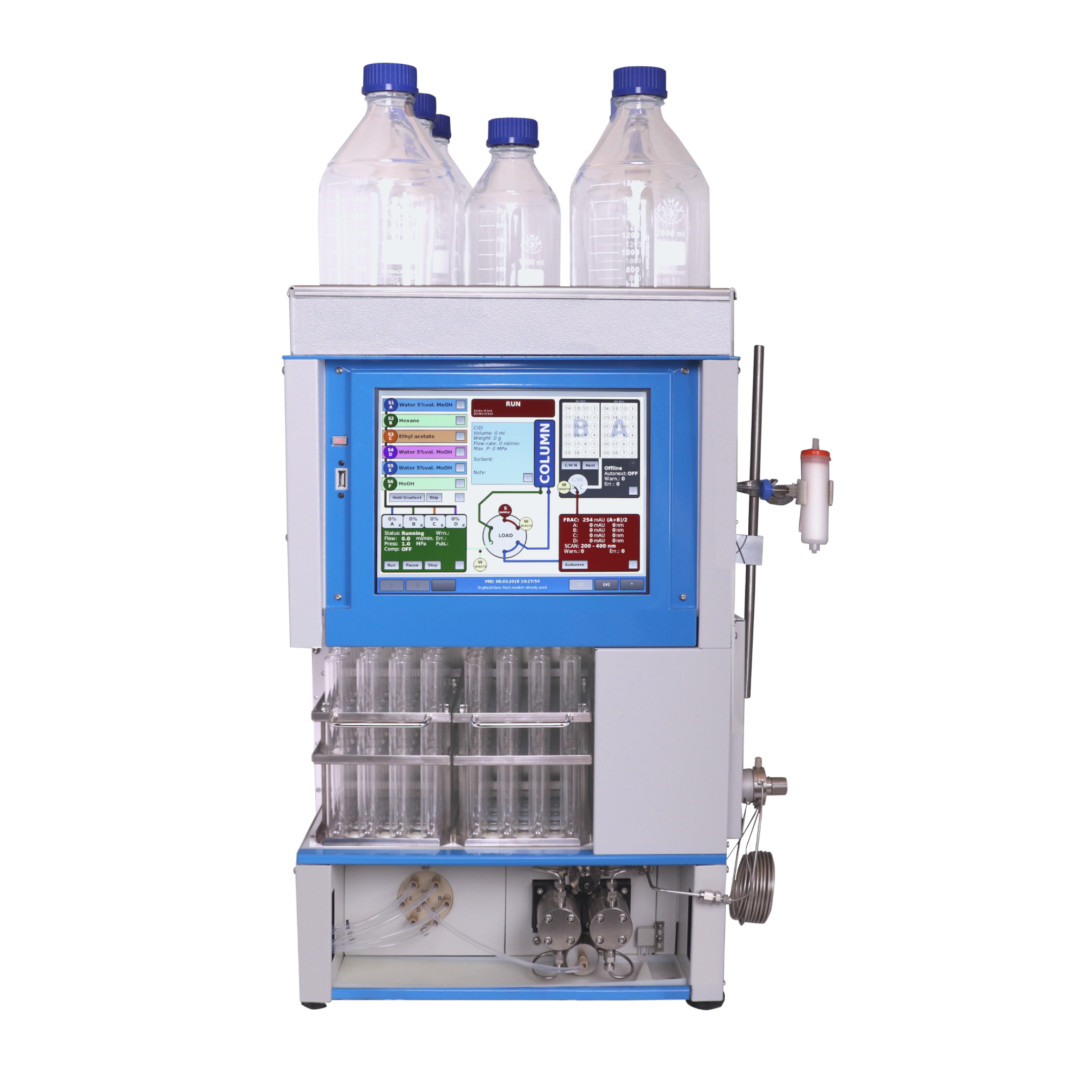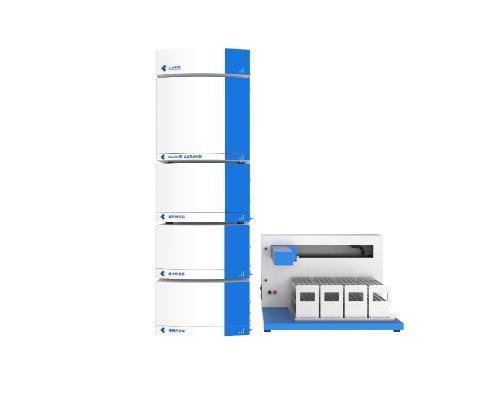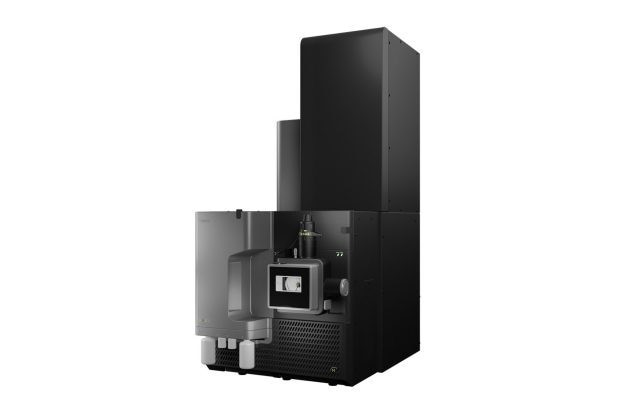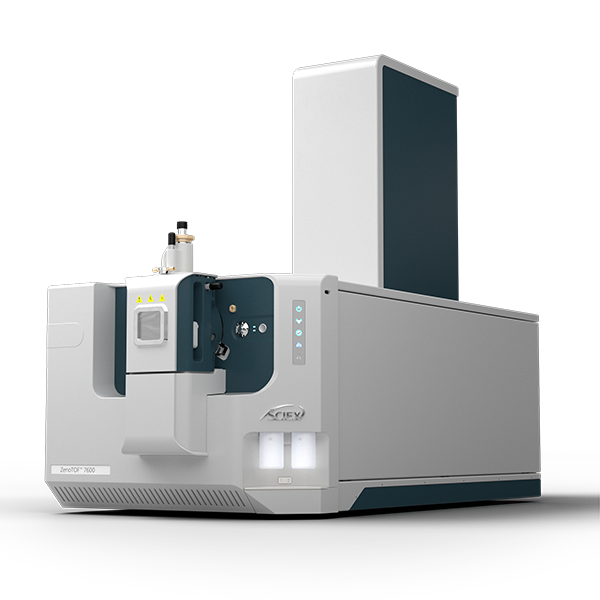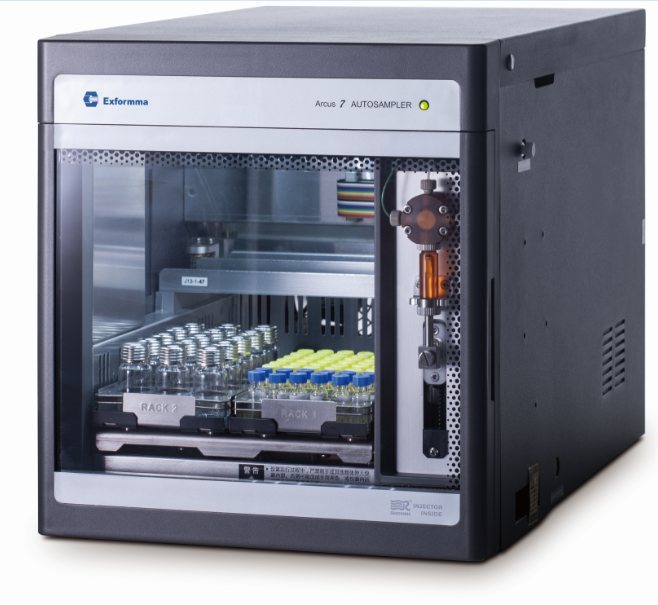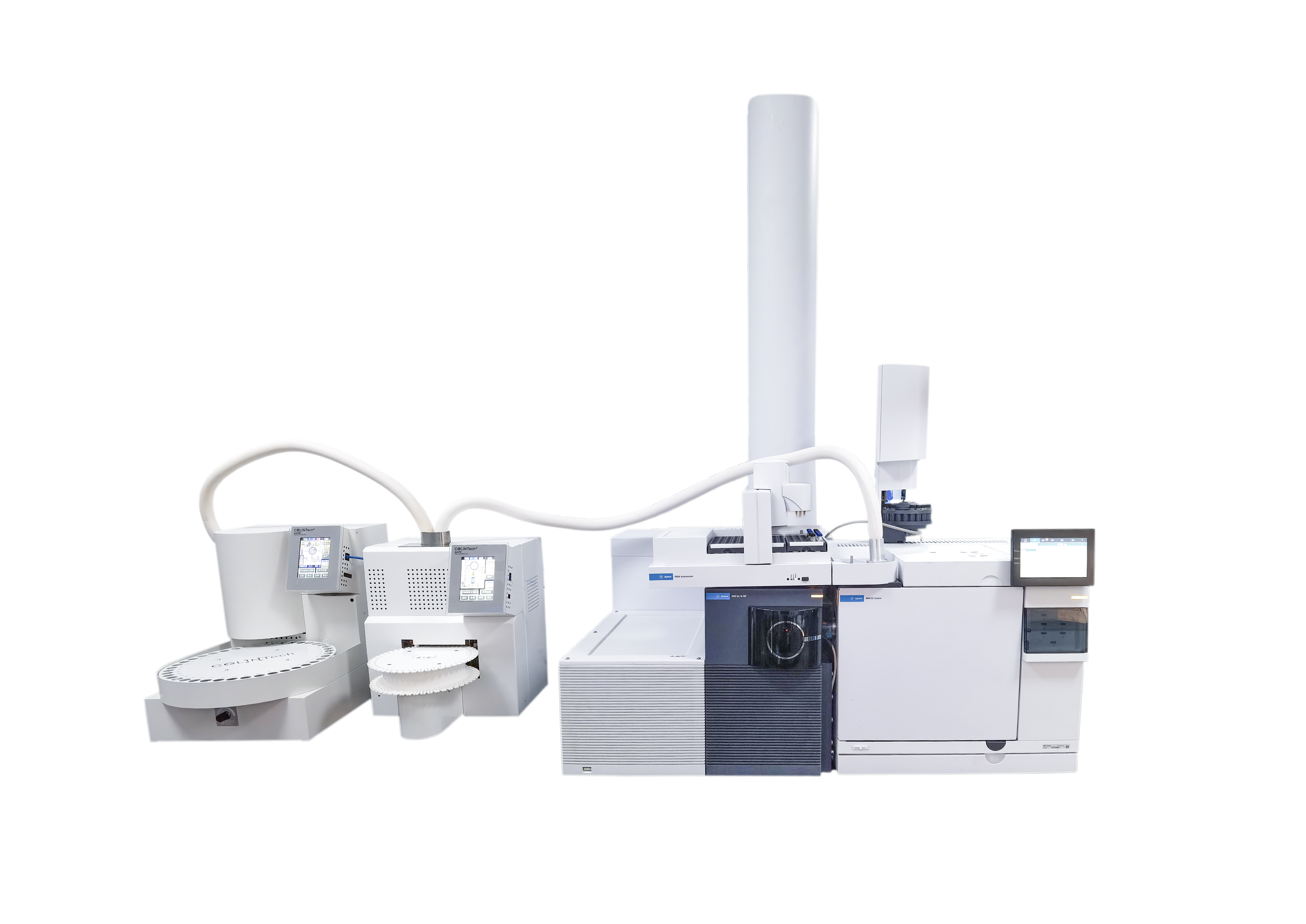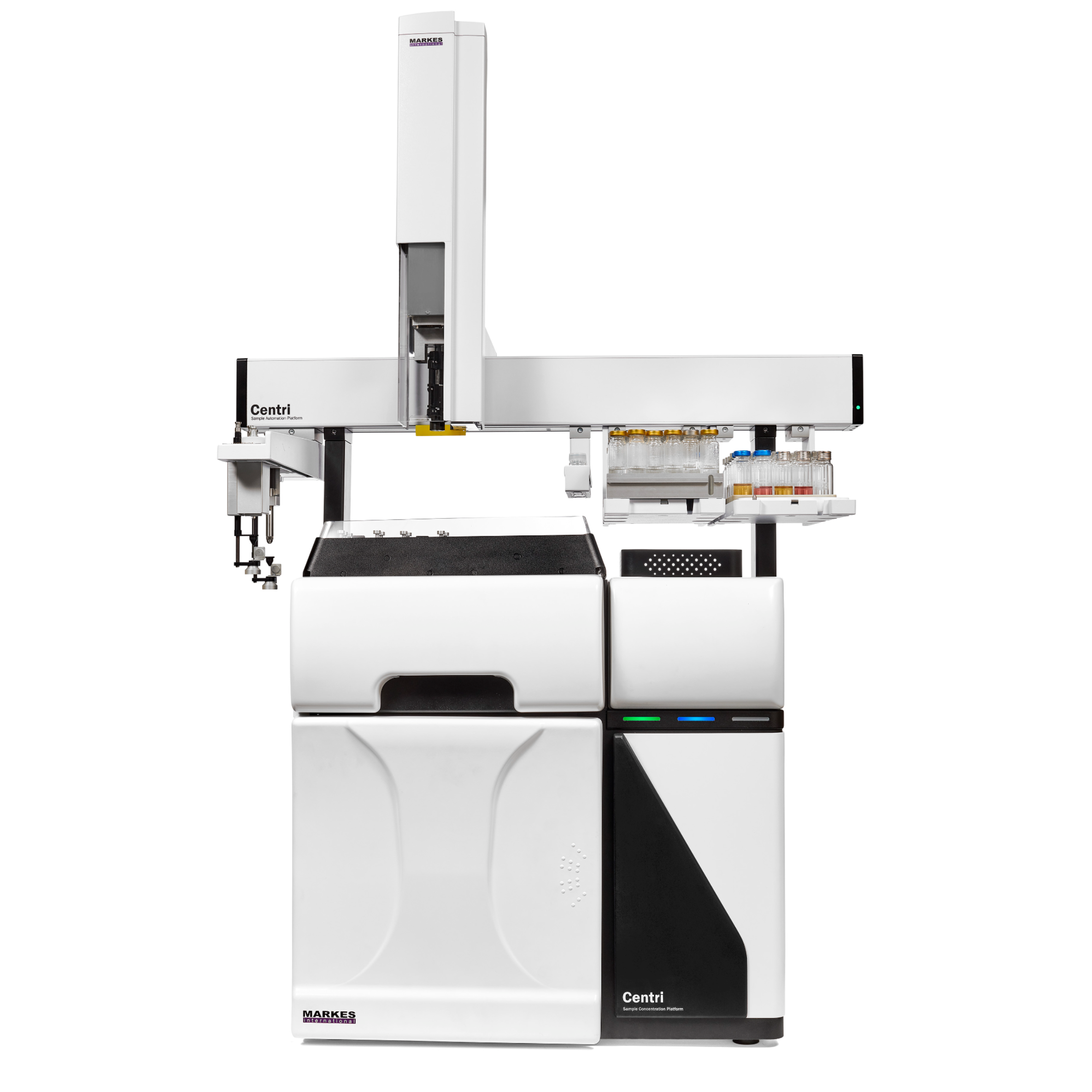方案详情
文
The purification of a valuable product or product library after a long and complex synthesis is a very important process. The Agilent Automated Purifi cation Software introduces an Open-Access-based solution for isolating substances, with automated focused gradient to simplify the pre- and post-purification steps.
This Technical Overview describes the easy steps to follow, from crude sample analytical scouting submission to pure target product archiving or screening. For example, a purification sample containing a target peak overlapped by an impurity was purifi ed on the Agilent 1260 Infinity Preparative-Scale LC/MS Purifi cation System using the Automated Purifi cation Software. This purifi cation produced a pure target compound with 88 % recovery, saving 40 % of solvent and runtime compared to a standard purifi cation method.
方案详情

Automated Workflow Solution forPreparative Chromatography FromAnalytical Scouting to Fraction Reanalysis Agilent Automated Purification Software onthe Agilent 1260 Infinity Preparative-ScaleLC/MS Purification System Technical Overview Author Abstract Pierre PenduffAgilent Technologies, Inc. Waldbronn, Germany The purification of a valuable product or product library after a long and complexsynthesis is a very important process. The Agilent Automated PurificationSoftware introduces an Open-Access-based solution for isolating substances,with automated focused gradient to simplify the pre-and post-purification steps. This Technical Overview describes the easy steps to follow, from crude sampleanalytical scouting submission to pure target product archiving or screening. Forexample, a purification sample containing a target peak overlapped by an impuritywas purified on the Agilent 1260 Infinity Preparative-Scale LC/MS PurificationSystem using the Automated Purification Software.This purification produceda pure target compound with 88 % recovery, saving 40 % of solvent and runtimecompared to a standard purification method. Agilent Technologies Introduction In synthetic chemistry, automation of thepurification process is one of the keys forincreasing the productivity of a researchgroup. Scaling-up a compound separationperformed on an analytical system toa preparative liquid chromatographysystem requires an optimization stepon the analytical column. This stepconcerns the development of thegradient method for the isolation of thetarget compound with the best balancebetween purity, throughput, and time. Forthese perspectives, a focused gradientprofile offers the best solution for thepurification of the target compound. Toenhance the fine focused gradient profile,the user must have a good knowledgeof preparative liquid chromatographyand method development (more detailabout the analytical to preparativescale-up process in the Agilent TechnicalOverview, 5991-2013EN). The Agilent Automated PurificationSoftware combines the performance ofthe focused gradients and automation ofthe preparative chromatography workflow.This add-on to the Agilent OpenLAB CDSChemstation gives users privileges in anOpen-Access work environment. To that end, the software provides twodifferent user modes: In the Expert Mode, users caneasily choose to use the defaultautomated purification settings oruse a customized method profile. In the Easy-Prep mode, theoperators follow the definedeasy-to-use user interface. The method used in the Easy-prepmode can only be fully managed andcustomized by the administrator. This Technical Overview describes thepurification steps in the Easy-Prep mode,described from the simplified operatorview. Experimental Instrument Analytical Agilent 1260 Infinity Binary LC/MS System comprised of: Agilent 1260 Infinity Binary Pump (G1312B) Agilent 1260 Infinity High Performance Degasser (G4225A) Agilent 1260 Infinity High Performance Autosampler (G1367E) Agilent 1260 Infinity Thermostatted Column Compartment (G1316A) Agilent 1260 Infinity Diode Array Detector (G1315C) equipped with the standard flow cell (G1315C#018)Agilent 6140 Single Quadrupole Mass Spectrometer Preparative Agilent 1260 Infinity Preparative-scale LC/MS Purification System comprised of: Agilent 1260 Infinity Preparative Pumps (G1361A, G1391A) Agilent 1260 Infinity Preparative Autosampler (G2260A) Agilent 1260 Infinity Diode Array Detector (G1315C) equipped with a Quartz flow cell 0.06-mm path length(G1315C#026) Agilent 1200 Series column organizer (G1383A) Agilent 1260 Infinity Fraction Collector PS (G1364B) Agilent 6120 Single Quadrupole Mass Spectrometer Column Agilent ZORBAX RRHT StableBond SB-C18,2.1×50 mm, 1.8 pm, (825700-902) comprised of:Agilent ZORBAX RRHT Cartridge Hardware Kit,50-mm (820555-901) Agilent ZORBAX Prep HT SB-C18, 21.2×100 mm, 5 pm (870100-902) with end fittings (820400-901) Software Agilent OpenLAB CDS ChemStation Edition for LC and LC/MS Systems, Rev. C.01.05 [40]Agilent Automated Purification Software Add-On, Rev. A.01.01 Solvents and samples Solvents A: Water+0.1 % formic acid Solvents B: Acetonitrile +0.1 % formic acid Purification mixture for analytical and preparative runs: Drug-like sample mixture All solvents used were LC grade, not degassed. Fresh ultrapure water was obtained from a Milli-QIntegral system equipped with a 0.22-pm membrane point-of-use cartridge (Millipak, EMD Millipore,Billerica, MA, USA). Chromatographic and spectrometric conditions Results and Discussion Analytical target confirmationTask creation After the completed reaction has beenmonitored on any Agilent analyticalsystem, such as a 1260 Infinity BinaryLC/MS System, the sample is submittedfor purification. The Easy-Prep userinterface of the Automated PurificationSoftware is divided into two differentsections, a task progression section anda task configuration and results section(Figure 1). In the task progression section, the useris invited to create a task with a batchname or sequence name to save the taskresults (analytical and preparative runs),for example, into a work group folder.This task is created with a combination ofsystems, one for the analytical run, andone for the preparative run. The resulting combination is thendisplayed and summarized in the taskconfiguration and results sectionunder the System Selection tab. Eachsystem description includes predefinedcharacteristics such as dwell volumes,column specifications, flow rates, delaytime between UV and MS, or delay timebetween detectors to fraction collectors. This system selection assigns theadministrator a predefined configurationof the preparative gradient profile, whichneeds to be applied for a specific scale-upprocess. In this particular case, the systemcharacteristics from the 1260 InfinityBinary System located in Laboratory 2and the Open-Access 1260 InfinityPreparative-Scale LC/MS System wereassigned for the purification process.A gradient profile was generated fromthe resulting combination of systems,taking into consideration the differentparameters of the scale-up process. Task progression section Figure 1. Agilent Automated Purification Software user interface under an Easy-Prep user view. Analytical target confirmation Analytical run(s) selection andpreparative task submission To complete the task submission, the userhas to browse the analytical result underthe analytical data root folder, and specifythe preparative sample tray locations andinjection volumes. Analytical mass-spectral data providesthe required information for identificationof the target peak. By extracting thetarget compound ion chromatogram, thesoftware automatically identifies thetarget peak for the preparative run. The chromatographic conditions of theanalytical data characterize the elution ofthis target peak. The preparative gradientis generated to focus on this elution area. The preparative task is submitted to therun queue from the Task ProgressionSection. Depending on the administratordefined user rights, at this step, theEasy-prep user submits the task andreviews the automated peak identificationor starts the purification process directly. + Add Task Delete Task GF-458-001-a Regular User (ocalhost)12/18/2013 5:54:10 PM12/4/20137:59:05 PM Action 6. Preparative task submission for:-Review before purification- Purification without review Automated purification Target peak and gradient review fromthe analytical run (Optional) If the Easy-Prep user is allowedto review the automated targetcompound identification; the analyticalchromatogram appears with a highlightedidentified target peak as shown inFigure 4. If the highlighted peak doesnot match the desired target compound,another target peak can be manuallyassigned. Then, the gradient profile willautomatically be updated to the newelution area of interest, and modify theautomated gradient profile used for thepreparative run (Figure 5). From the system characteristics and theelution area of the target peak, a focusedgradient was generated to increase thechromatographic selectivity to the targetpeak and reduce the run time of thepreparative run (Figure 5). Figure 4. Automated target peak identification from the analytical data and target mass. Preparative run review After submission and execution ofthe purification run, a summary of thepreparative result can be reviewed in theTask Configuration and Results section(Figure 6). This tab shows the: Preparative sample(s) locationfrom the autosampler tray (top left) Collected fraction(s) location(s)and their crude sample mixture(s)belonging (top right) Preparative chromatogram ofthe selected sample mixturepurification (bottom left) Average spectral data of theselected fraction (bottom right) This information can be exported forpooling of fraction or reformatting thesample location for fraction reanalysis, forexample. Fraction purity evaluation andpooling The preparative results data, and theaverage spectral data of the selectedfraction, give a good evaluation of thefractions to select for fraction pooling,solvent evaporation, and conditioning orbiological screening. In this example, the resulting fractionspectral data are shown in Figure 7. The purification results tab provides aneasy way to export the selected fractionsto a liquid handler or an analytical LCsystem (Figure 8). Purity Purity evaluation,determination Automated fraction pooling purification Analytical target confirmation Crude sample product information Figure 7. Selected collected fraction and average spectral data. After purification, the collected fractionwas reanalyzed on the 1260 InfinityBinary LC/MS system. In this examplepurification, 88 % recovery of a puretarget compound (Figure 9), was achievedafter purification of the crude mixturecorresponding to 54 mg of pure targetproduct. Conclusion The Agilent Automated PurificationSoftware Add-On coupled with theAgilent OpenLAB CDS ChemStationEdition for LC and LC/MS Systems offersan automated solution to achieve higherthroughput. With an automated on-the-fly gradientgeneration, based on the target massor formula of the desired product, thechromatographic selectivity is increasedon the automated identified target peak.Thus,the optimized purification methodallows shorter run time and decreasesthe solvent consumption by 40 %. Furthermore, with the Easy-prep modeof the Automated Purification Software,preparative method development is nolonger required,opening access of thepurification system to nonexpert userswith diverse chromatographic experience. This Technical Overview demonstrateshow 54 mg of a targeted compound waspurified using the Agilent 1260 InfinityPreparative-Scale LC/MS PurificationSystem, with 88 % recovery and 100 %purity. Reference 1. Penduff, P., Analytical to PreparativeHPLC Method Transfer: An easvway to scale up from UHPLC topreparative HPLC using focusedgradients, Agilent TechnologiesTechnical Overview, publicationnumber 5991-2013EN, 2013. 2 3 Figure 9. Agilent OpenLAB CDS ChemStation data analysis of the collected fraction. www.agilent.com/chem This information is subject to change without notice. @ Agilent Technologies, Inc., 2014 Published in the USA.March 1, 2014 5991-4115EN Agilent Technologies Abstract The purification of a valuable product or product library after a long and complex synthesis is a very important process. The Agilent Automated Purifi cation Software introduces an Open-Access-based solution for isolating substances, with automated focused gradient to simplify the pre- and post-purification steps. This Technical Overview describes the easy steps to follow, from crude sample analytical scouting submission to pure target product archiving or screening. For example, a purification sample containing a target peak overlapped by an impurity was purifi ed on the Agilent 1260 Infinity Preparative-Scale LC/MS Purifi cation System using the Automated Purifi cation Software. This purifi cation produced a pure target compound with 88 % recovery, saving 40 % of solvent and runtime compared to a standard purifi cation method.IntroductionIn synthetic chemistry, automation of the purifi cation process is one of the keys for increasing the productivity of a research group. Scaling-up a compound separation performed on an analytical system to a preparative liquid chromatography system requires an optimization step on the analytical column. This step concerns the development of the gradient method for the isolation of the target compound with the best balance between purity, throughput, and time. For these perspectives, a focused gradient profi le offers the best solution for the purifi cation of the target compound. To enhance the fi ne focused gradient profi le, the user must have a good knowledge of preparative liquid chromatography and method development (more detail about the analytical to preparative scale-up process in the Agilent Technical Overview, 5991-2013EN1 ). The Agilent Automated Purifi cation Software combines the performance of the focused gradients and automation of the preparative chromatography workfl ow. This add-on to the Agilent OpenLAB CDS Chemstation gives users privileges in an Open-Access work environment. To that end, the software provides two different user modes: • In the Expert Mode, users can easily choose to use the default automated purifi cation settings or use a customized method profi le. • In the Easy-Prep mode, the operators follow the defined easy-to-use user interface. The method used in the Easy-prep mode can only be fully managed and customized by the administrator. This Technical Overview describes the purifi cation steps in the Easy-Prep mode, described from the simplifi ed operator view.Conclusion The Agilent Automated Purifi cation Software Add-On coupled with the Agilent OpenLAB CDS ChemStation Edition for LC and LC/MS Systems offers an automated solution to achieve higher throughput. With an automated on-the-fl y gradient generation, based on the target mass or formula of the desired product, the chromatographic selectivity is increased on the automated identifi ed target peak. Thus, the optimized purifi cation method allows shorter run time and decreases the solvent consumption by 40 %. Furthermore, with the Easy-prep mode of the Automated Purifi cation Software, preparative method development is no longer required, opening access of the purifi cation system to nonexpert users with diverse chromatographic experience. This Technical Overview demonstrates how 54 mg of a targeted compound was purifi ed using the Agilent 1260 Infi nity Preparative-Scale LC/MS Purifi cation System, with 88 % recovery and 100 % purity.
确定
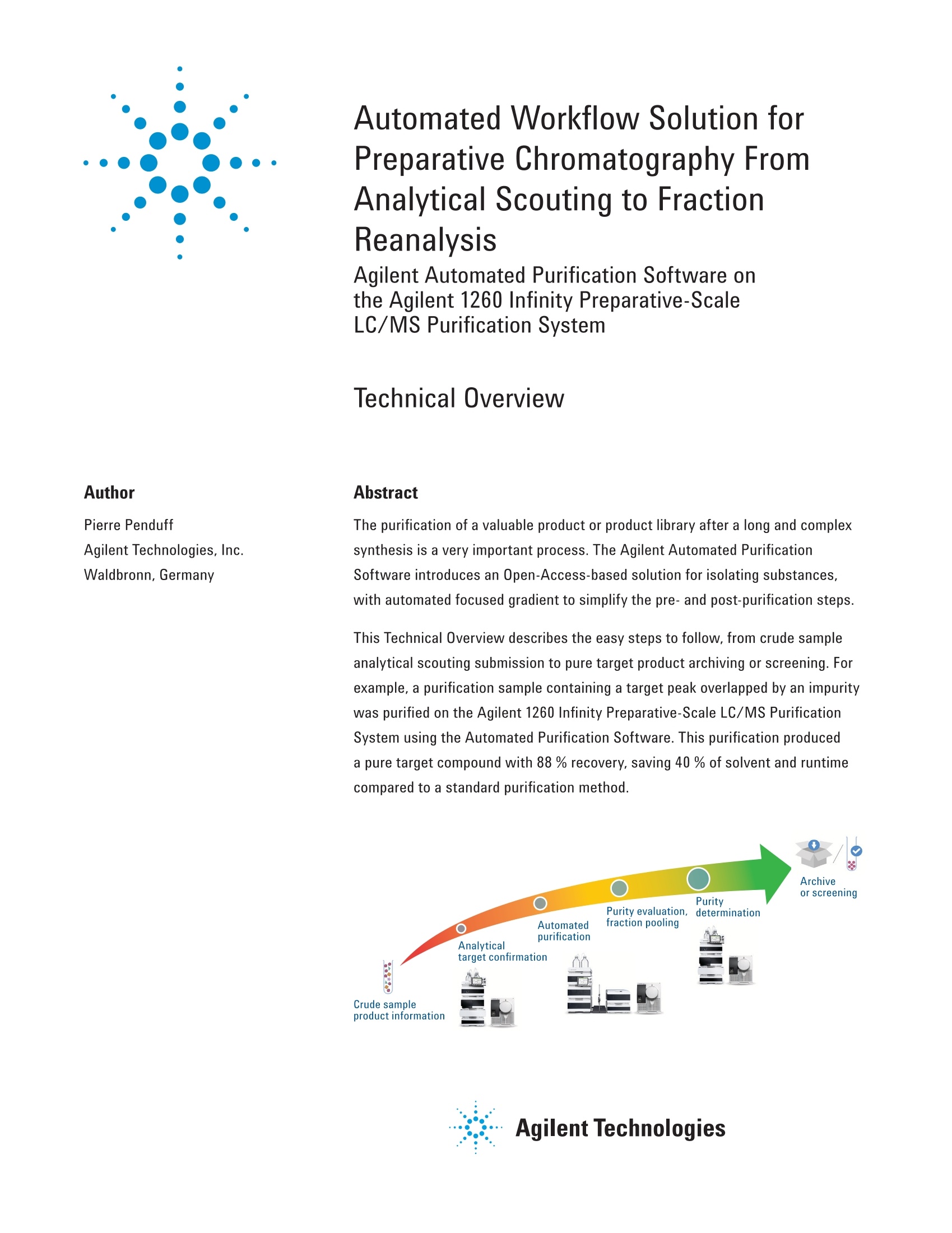
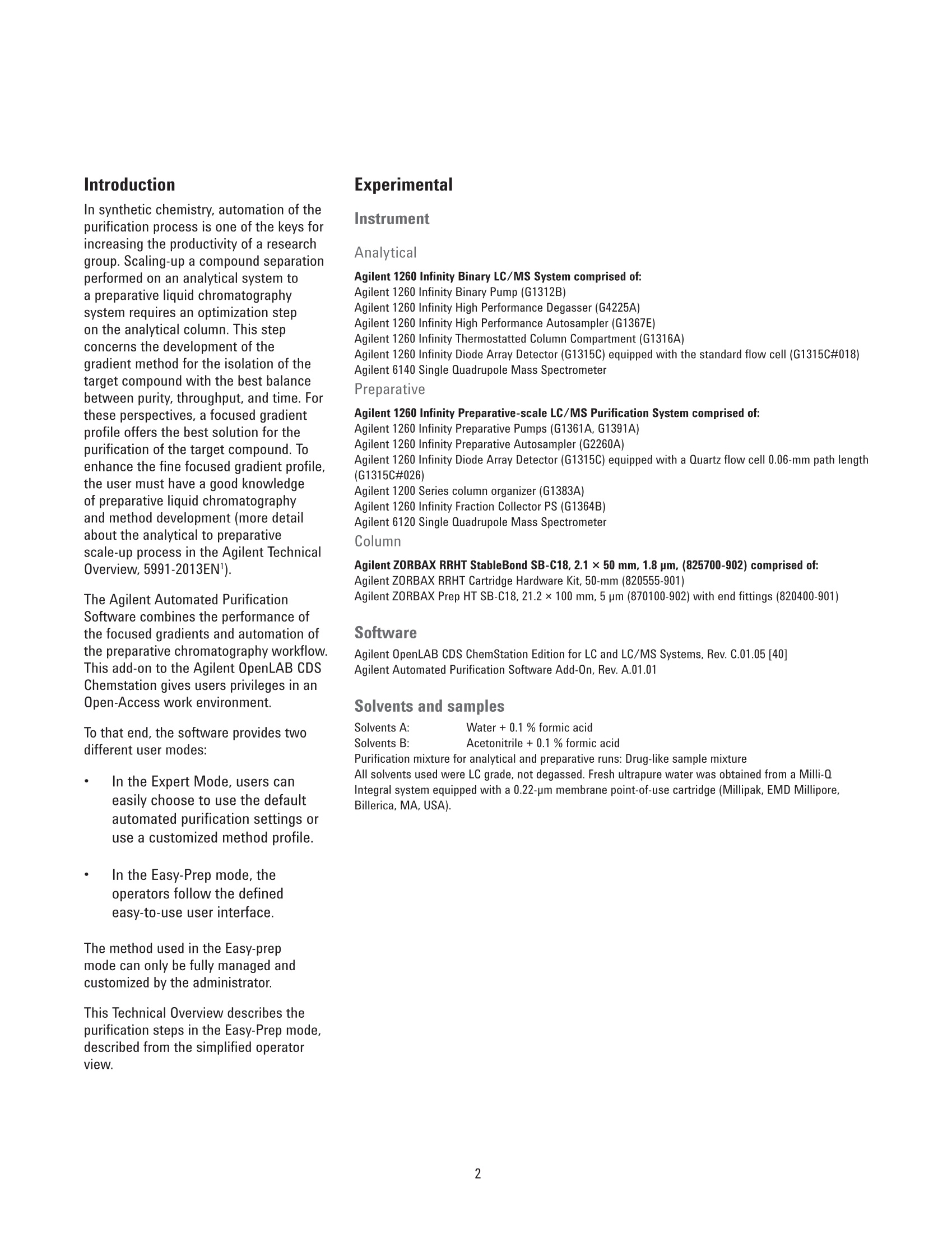
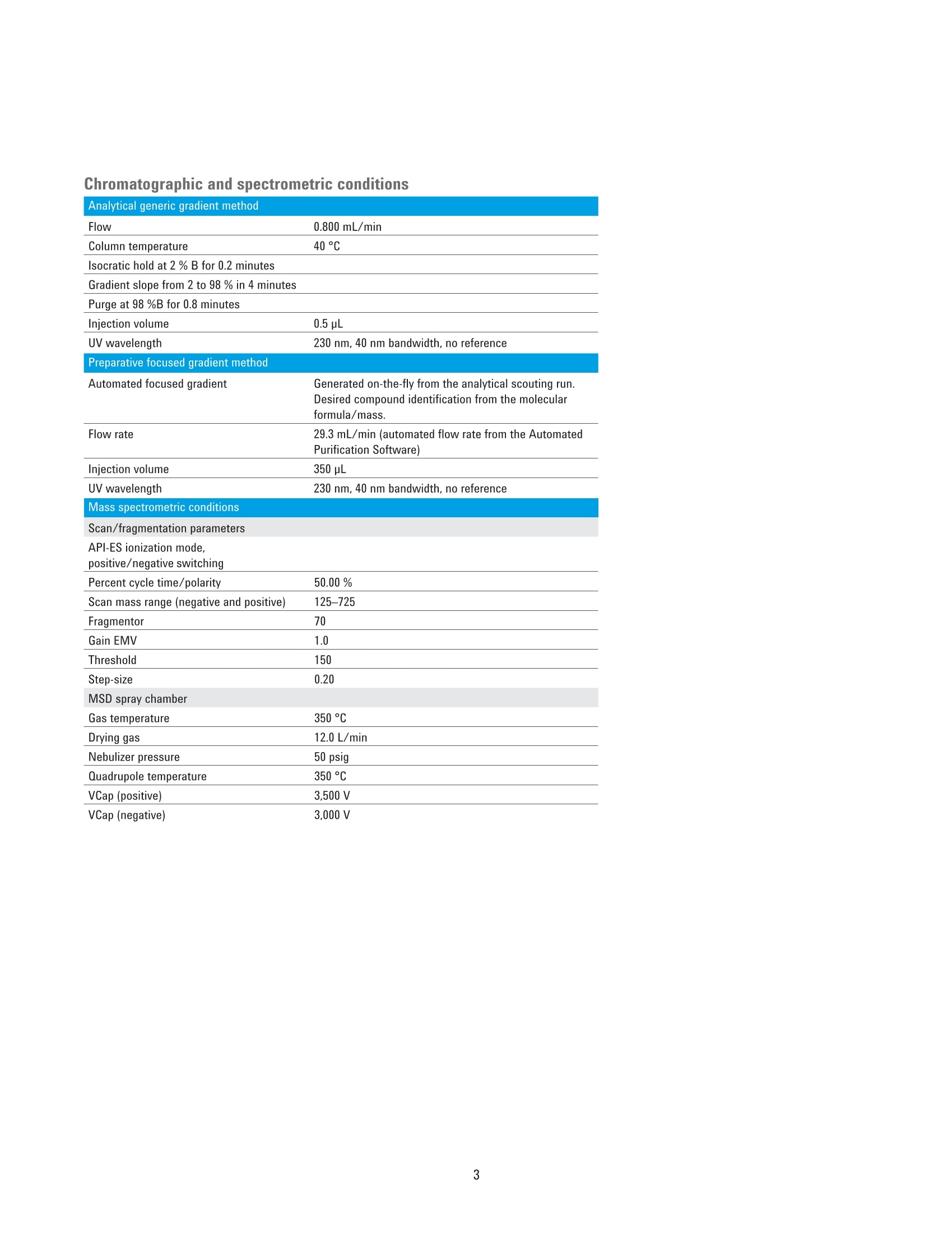
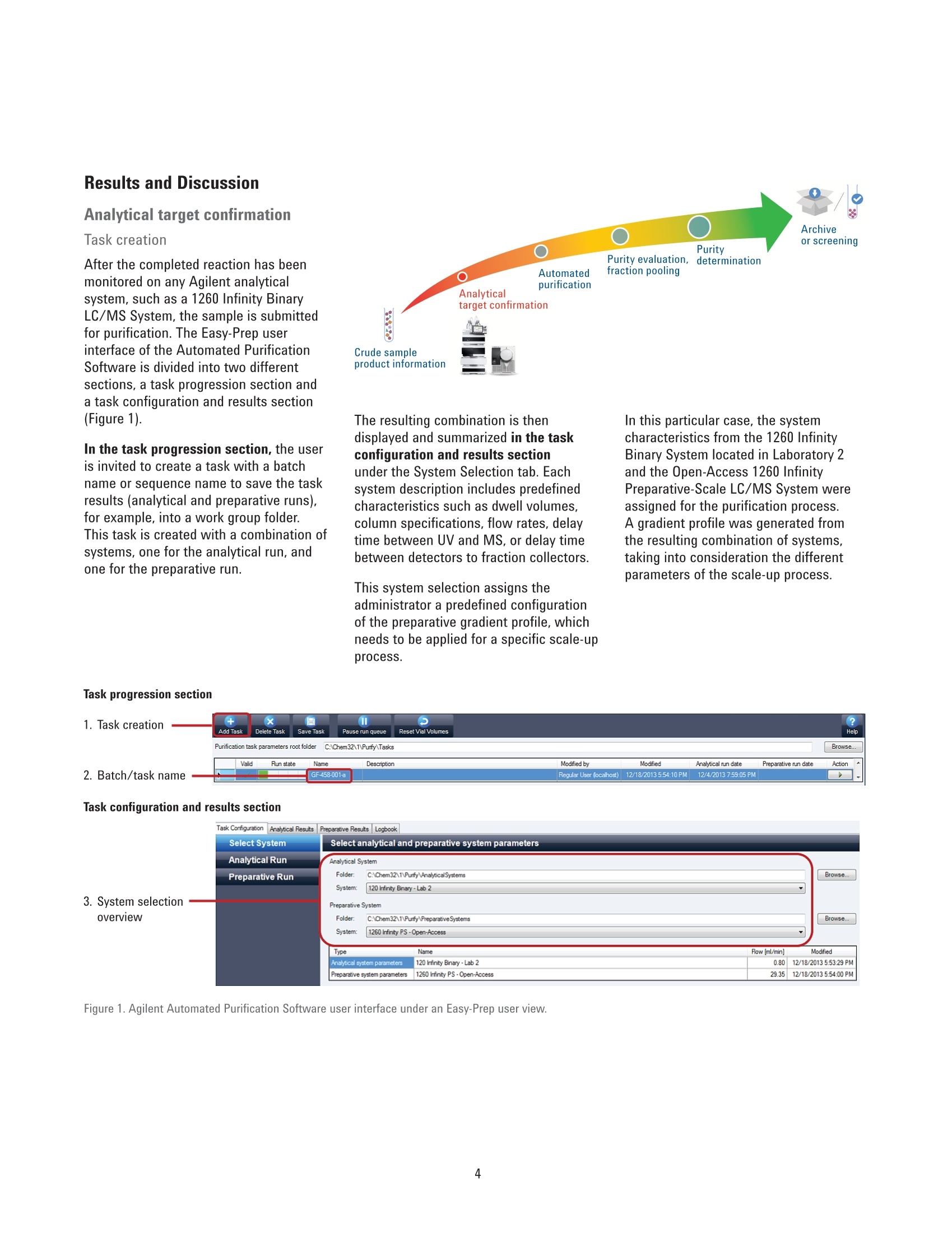
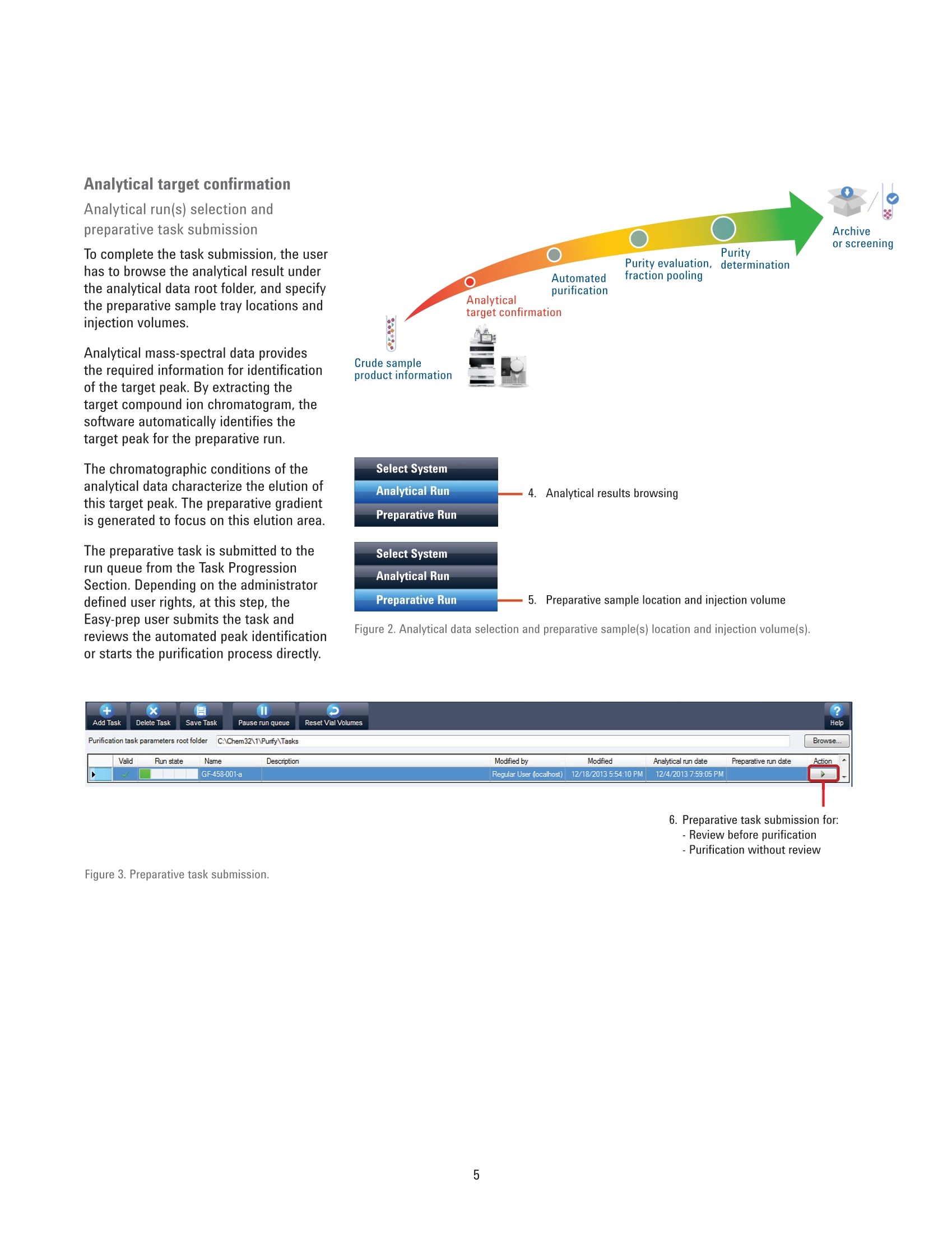
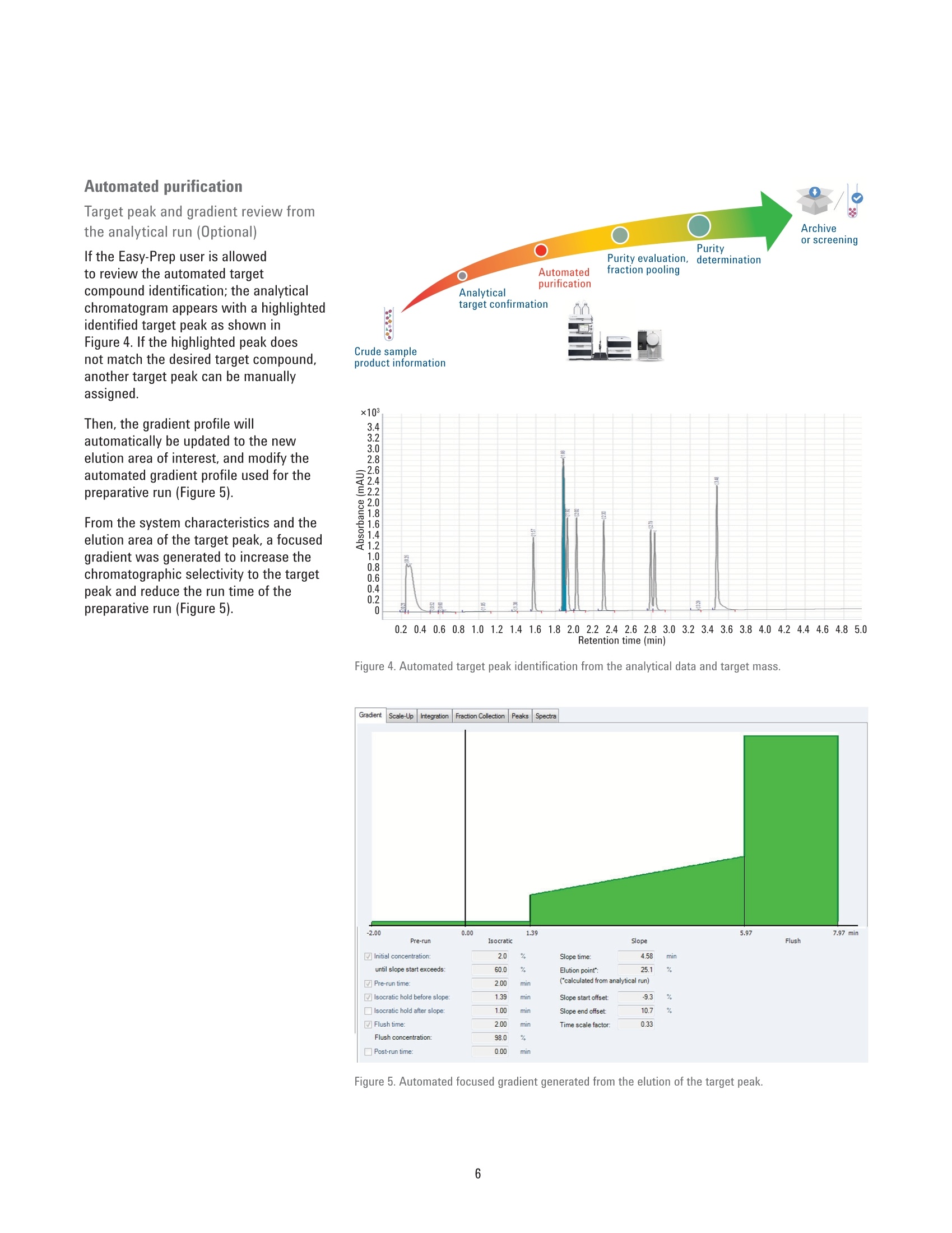
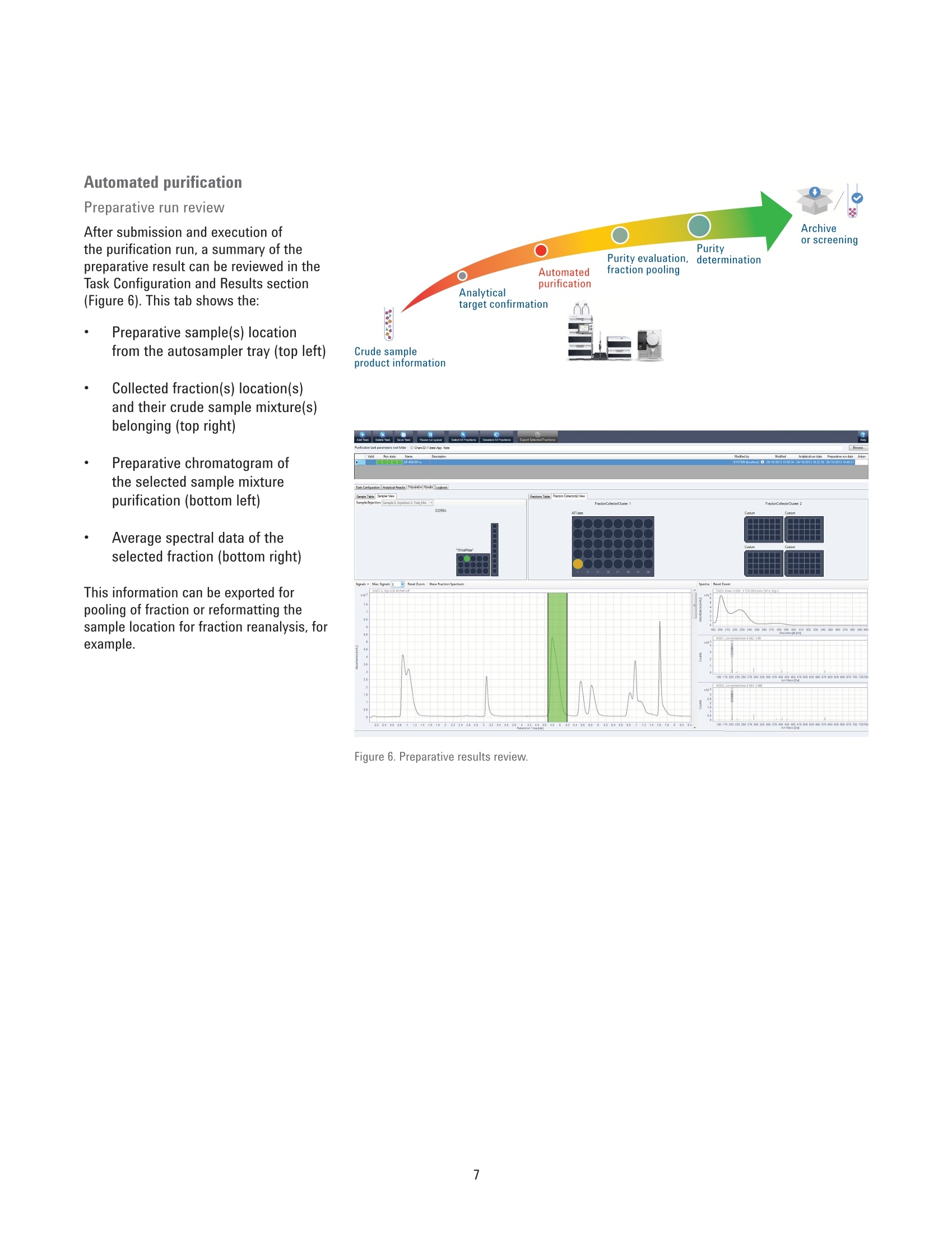
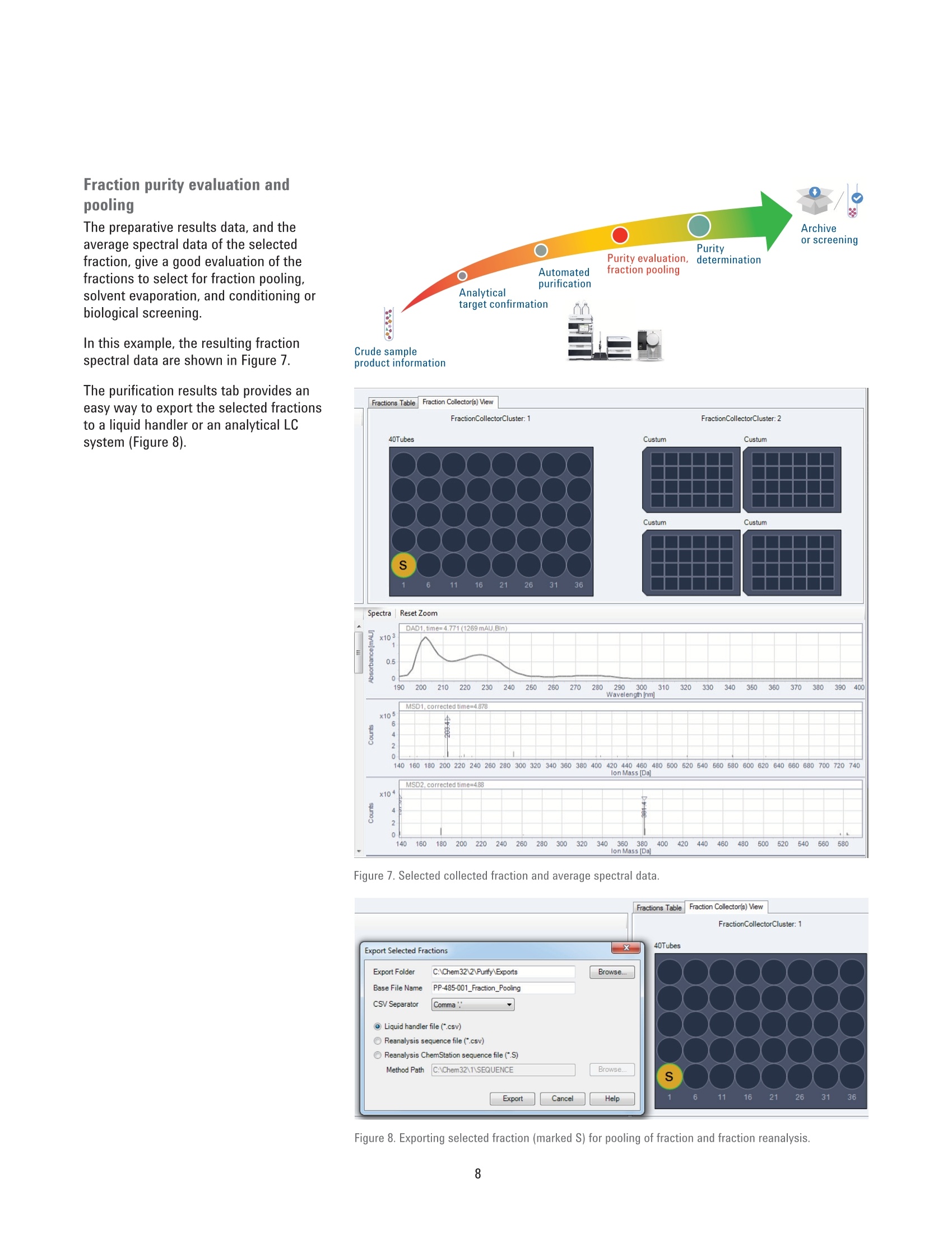
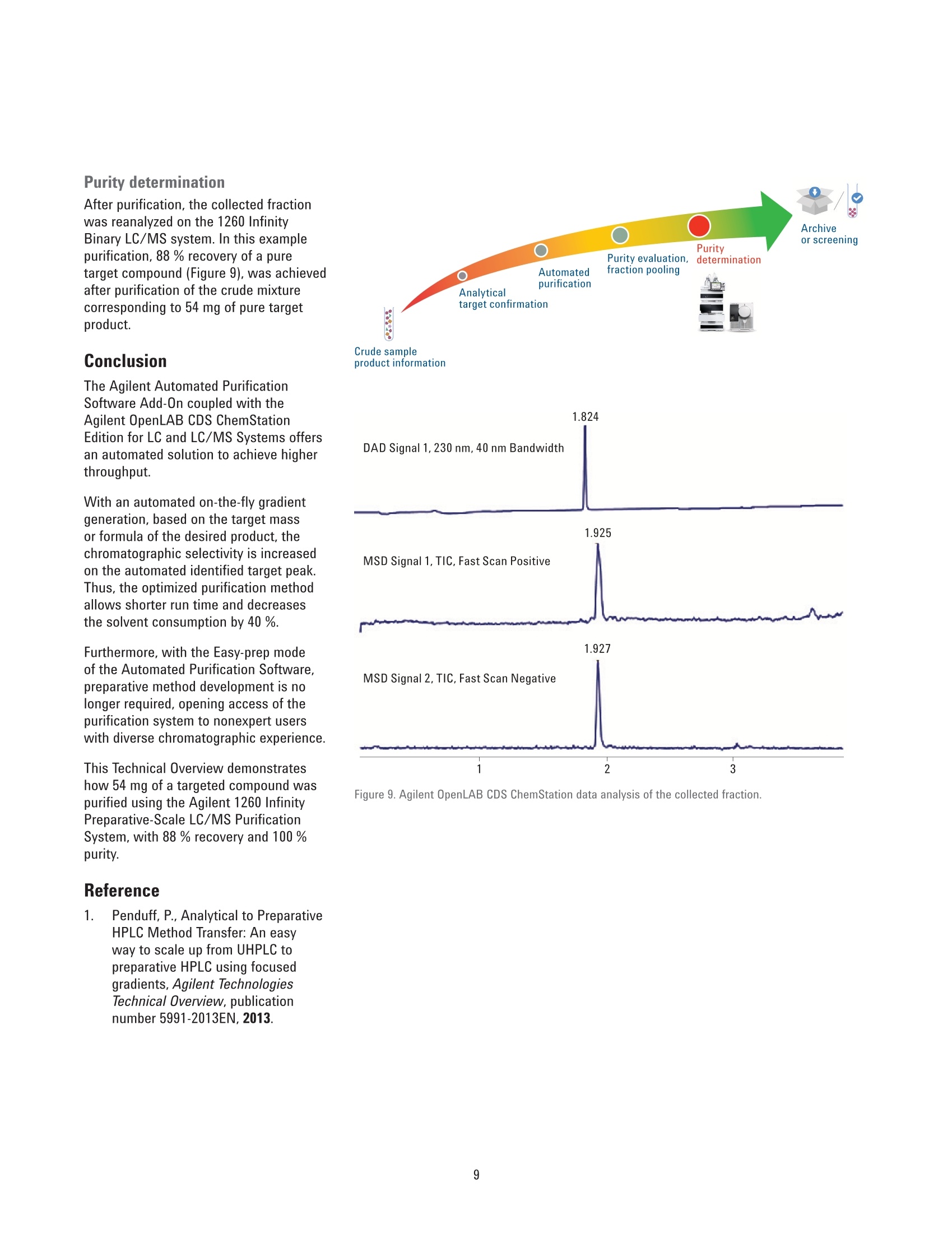
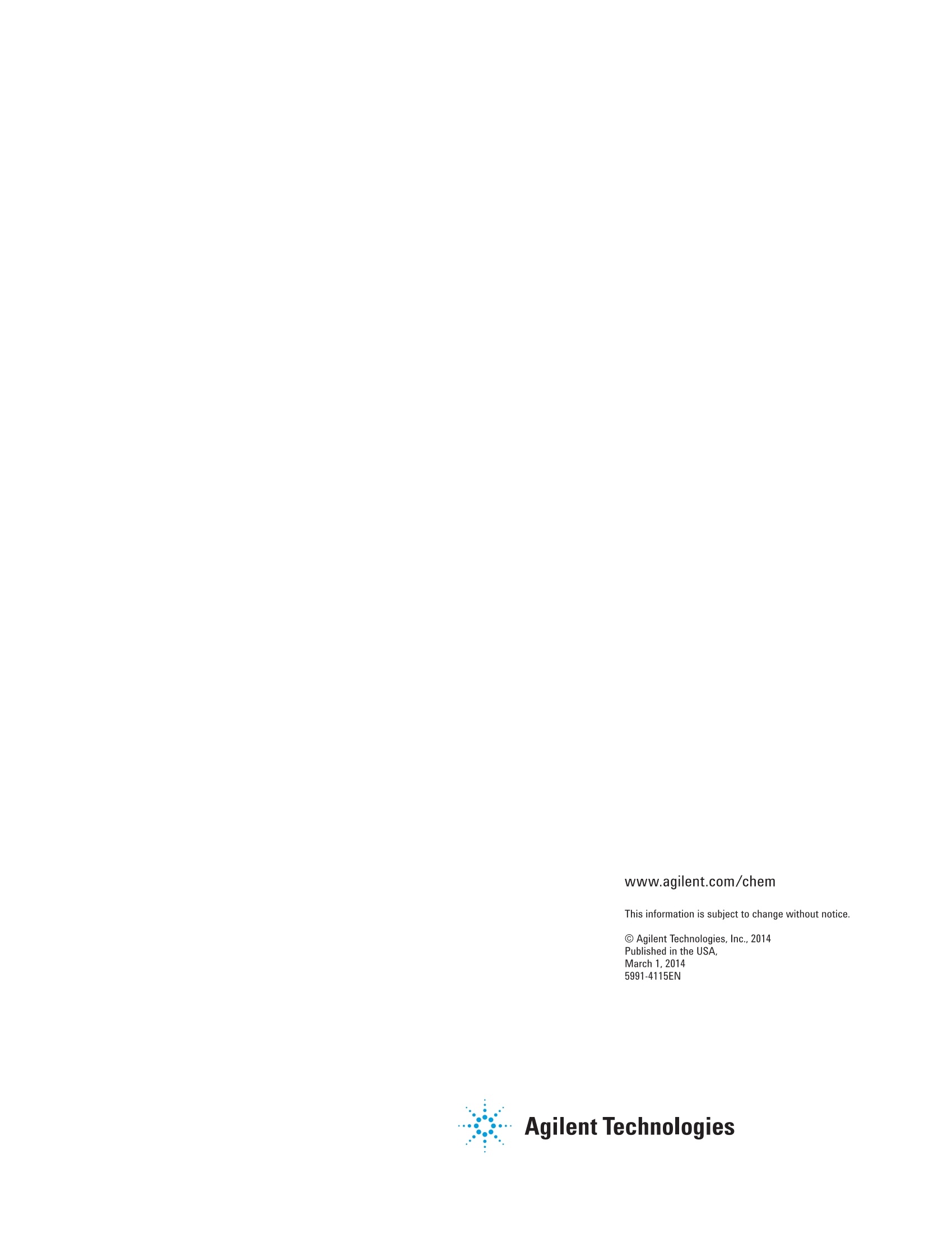
还剩8页未读,是否继续阅读?
安捷伦科技(中国)有限公司为您提供《混合标样中咖啡因,4-羟基苯甲酸甲酯等检测方案(制备液相色谱)》,该方案主要用于其他中其他检测,参考标准--,《混合标样中咖啡因,4-羟基苯甲酸甲酯等检测方案(制备液相色谱)》用到的仪器有Agilent 1260 Infinity II 制备型液相色谱、Agilent 6100 系列单四极杆液质联用系统、Agilent 1290 Infinity II Multisampler、OpenLAB 软件
推荐专场
相关方案
更多
该厂商其他方案
更多

